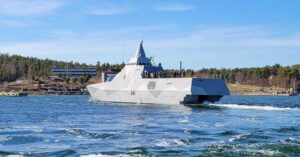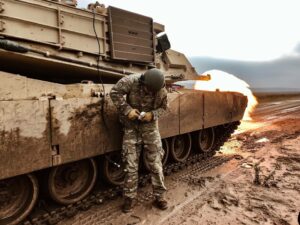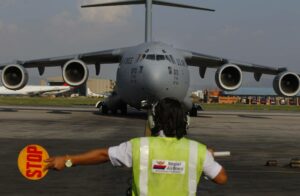
Watching Ukrainian resistance to Russia, some say the U.S. military needs to embrace a defense-dominant approach to aerial warfare centered on large numbers of small, short-range, inexpensive drones. In their view, the U.S. should move away from small inventories of advanced, expensive inhabited aircraft that can project power over long distances. Instead, they argue, the U.S. needs to rapidly field a “moneyball” military of small, cheap autonomous things. It’s the U.S. force-planning equivalent of exploiting inefficiencies to snatch up undervalued baseball players with high on-base percentages.
But this argument misses the importance of finding the right balance between high-value capabilities and larger numbers of less expensive (and less capable) assets.
Often overlooked in the moneyball analogy is the contribution of an all-star pitching rotation to the 2002 Oakland A’s winning streak. Tim Hudson, Barry Zito and Mark Mulder don’t fit the scrappy underdog narrative — each rank among Oakland’s all-time top 10 in wins, strikeouts and winning percentage — but Oakland couldn’t have done it without them. It’s the same with the U.S. military’s approach to building a combat-credible force to deter China. The U.S. will need to employ advanced fighters, bombers and support aircraft, and combine them in creative ways with existing and new drone technologies.
While low-cost, expendable “position player” drones are critical, especially for decoy and surveillance missions, other U.S. drones will need military-class capabilities as unique as Barry Zito’s famous curveball, such as range, stealth, survivability, autonomy, and sophisticated sensors and payloads.
To be sure, in Ukraine the short-range, commercial-quality and the Soviet-era drones have helped stave off a quick defeat. So it’s not that smaller commercial drones can’t make a difference in a China fight; they might very well be critical — particularly for a weaker ally like Taiwan, which can learn from Ukraine’s effective use of layered, low-cost defenses to create a virtual wall around its sovereign territory.
U.S. forces also will need large numbers of low-cost drones to bring mass to the battlespace and increase the survivability of high-value inhabited stealth aircraft — both critical aims in a war with China that could see attrition on par with World War II.
But it would be a mistake to apply Ukraine’s approach to drone innovation wholesale to U.S. forces. Kyiv and Moscow have saturated the battlespace with $2,000 Chinese-made DJI quadcopters to contest airspace and bring the air battle to a stalemate. But quadcopter dogfights are not a viable theory of victory in the Indo-Pacific, where the problem facing U.S. forces is blunting and halting a Chinese invasion of Taiwan.
Nearly 100 nautical miles of ocean — the Taiwan Strait — stand between Taiwan and China, and the nearest U.S. bases are likely to come under intense air and missile attacks in the event of a conflict. To deter Beijing and reassure allies and partners, U.S. forces need to be able to project power and gain windows of air superiority. Very small, very cheap drones with flight times as low as 46 minutes are not going to cut it.
The operational realities of great power conflict require military-class drones that can sense and target invasion forces as well as generate and sustain combat power while under attack. Next-generation drones can leverage new commercial sensors and innovative manufacturing practices to reduce costs, but they also need some sophisticated capabilities that can’t be bought on the internet.
Probably the biggest factor shaping requirements for U.S. drones in the Indo-Pacific is range. In Ukraine, short-range military and commercial drones have proved effective for artillery spotting and some direct attacks on the front lines. But missile threats to U.S. air bases will require drones to base farther away, in places like the Japanese islands or the Philippines. Mitchell Institute research suggests drones may need minimum ranges of 1,500 nautical miles just to effectively complete a mission inside the first island chain. These range requirements drive up costs as platform size increases to accommodate bigger engines and more fuel.
Survivability is also a major consideration. One answer is to build lots of small, autonomous drones that are essentially disposable. But if the drones are operating alongside stealth aircraft, or carrying sophisticated sensors or payloads, they may need advanced, low-observable capabilities to maintain an element of surprise to survive to their targets.
And autonomous drones — which can operate with some degree of independence from human control — will be important to speed up decision-making, reduce the burden on aircrews and minimize reliance on vulnerable data links.
Finally, a critical consideration is rapid fielding. The U.S. Air Force, the U.S. Navy and the U.S. Marine Corps are all pursuing crash efforts to develop new drone concepts and capabilities to prevent China from making a move on Taiwan. Some have suggested that fielding drones with advanced capabilities will just take too long. But there are already promising low-cost, autonomous and survivable drone technologies available today, as well as significant opportunities to turn long-endurance, current-generation drones into smart sensors that can autonomously detect maritime targets over the vast Indo-Pacific ocean.
As the president prepares to send his fiscal 2024 budget request to Capitol Hill, lawmakers should not assume that the lowest-cost solution is always the best bet. Of course, it would be a waste not to capitalize on low-cost drone technologies to increase our own operational resiliency and raise the costs of aggression for China. But not every drone can be a position player. Sometimes you just need a Barry Zito to bring it home.
Caitlin Lee leads the Center for UAV and Autonomy Studies at the Mitchell Institute for Aerospace Studies.
- SEO Powered Content & PR Distribution. Get Amplified Today.
- Platoblockchain. Web3 Metaverse Intelligence. Knowledge Amplified. Access Here.
- Source: https://www.defensenews.com/opinion/commentary/2023/02/17/how-to-make-smart-trades-across-us-drone-forces/
- 000
- 1
- 10
- 100
- 2024
- 70
- a
- Able
- accommodate
- across
- advanced
- Aerospace
- aims
- AIR
- aircraft
- airspace
- All
- Ally
- alongside
- already
- always
- among
- and
- answer
- Apply
- approach
- argue
- argument
- around
- Assets
- attack
- Attacks
- attrition
- autonomous
- autonomous drones
- autonomously
- available
- Balance
- base
- Baseball
- Battle
- Beijing
- BEST
- Bet
- between
- bigger
- Biggest
- bought
- bring
- budget
- build
- Building
- burden
- capabilities
- capable
- capitalize
- carrying
- Center
- centered
- chain
- cheap
- China
- chinese
- combat
- combine
- come
- commercial
- complete
- concepts
- conflict
- consideration
- contest
- contribution
- control
- Costs
- could
- course
- Crash
- create
- Creative
- critical
- Cut
- data
- Decision Making
- Degree
- develop
- difference
- direct
- DJI
- Dont
- drive
- drone
- Drones
- each
- Economist
- Effective
- effectively
- efforts
- Engines
- Equivalent
- especially
- essentially
- Event
- Every
- existing
- expensive
- facing
- famous
- field
- fight
- fighters
- finding
- First
- Fiscal
- fit
- flight
- Force
- Forces
- from
- front
- Fuel
- Gain
- generate
- going
- great
- great power
- halting
- helped
- High
- Home
- House
- How
- How To
- HTTPS
- human
- images
- importance
- important
- in
- Increase
- Increases
- independence
- inexpensive
- Innovation
- innovative
- instead
- Institute
- Internet
- invasion
- island
- Islands
- IT
- Japanese
- large
- larger
- lawmakers
- layered
- Leads
- Lee
- Leverage
- likely
- lines
- links
- Long
- Low
- maintain
- major
- make
- Making
- manufacturing
- Marine
- Maritime
- mark
- Mass
- might
- Military
- minimum
- misses
- Mission
- missions
- mistake
- more
- Moscow
- move
- NARRATIVE
- Need
- needs
- New
- next-generation
- numbers
- Oakland
- ocean
- ONE
- operate
- operating
- operational
- opportunities
- Other
- own
- particularly
- partners
- percentage
- Philippines
- pitching
- Places
- platform
- plato
- Plato Data Intelligence
- PlatoData
- player
- players
- position
- power
- practices
- Prepares
- president
- prevent
- Problem
- project
- promising
- proved
- Quick
- raise
- range
- rapid
- rapidly
- realities
- reduce
- reliance
- request
- require
- Requirements
- research
- Russia
- same
- sense
- sensors
- shaping
- should
- significant
- Size
- small
- smaller
- smart
- So
- solution
- some
- sophisticated
- sovereign
- speed
- stand
- Stealth
- studies
- such
- support
- surprise
- surveillance
- survive
- Taiwan
- Take
- Target
- targets
- Technologies
- The
- The Philippines
- their
- things
- threats
- times
- to
- today
- too
- top
- Top 10
- trades
- TURN
- u.s.
- UAV
- Ukraine
- Ukraines
- under
- unique
- us
- use
- Vast
- viable
- View
- Virtual
- Vulnerable
- war
- Waste
- ways
- which
- while
- wholesale
- will
- windows
- winning
- Wins
- without
- world
- would
- zephyrnet












